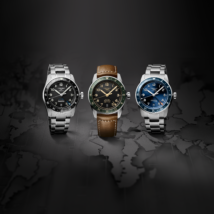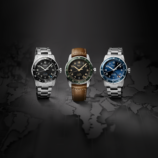Time-Recorder
Chronographs are among the most stylish and functional watchmaking complications. Their typical appearance – either sporty or elegant – is uniquely distinctive.
Chrónos and gráphein
The history of chronographs, which allows short intervals of time to be measured using a pusher, goes back to the first half of the 19th century. The term is formed by the Greek words chrónos for ‘time’ and gráphein for ‘write’.
1862 saw the introduction of the first pocket watch fitted with a zero heart-cam reset, which would be classed as a chronograph in today’s terms. The hand could be reset to zero by pressing a button. However the dual button system, rather than the single button one, has generally taken hold. One button serves to start and stop timing, the other to reset the timer to zero.
Flyback-Chronograph
Flyback chronographs enable stopping of the timer function while the chronograph is running by depressing a pusher once and reset the hand to zero. When the button is released, timing restarts anew.
Rattrapante
Rattrapante or split-second chronographs have two superimposed seconds hands, which time successively and display the difference in the times measured.
Larger than normal wristwatches
Chronographs are usually larger than normal wristwatches. This is due to the complexity of the watch movements and to the importance of good visibility so that the tachymeter scale and the totalisers can be read properly. These small sub-dials normally show the hours and minutes of the time already elapsed (usually as a 30-minute counter) and the seconds of the clock time, while the elapsed seconds are shown in the centre.
Tachymeter scale
Some chronographs have a tachymeter scale around the bezel or one around the edge of the watch face. So, in order to measure the speed of a vehicle, for example, you measure the time for a known distance, e.g. 1 km, on the tachymeter scale. If the time taken to travel it is 30 seconds, the tachymeter scale will show 120 km/h. In addition, chronographs offer other practical functions for everyday use. You can time how long phone calls last, the length of a meeting or cooking or exercise times.
Juwelier Wagner has a broad range of different model chronographs available, both classic and sporty, that will meet the most discerning of requirements. To make sure you continue to have many years of pleasure from these very special watches, our in-house watchmaker workshop provides regular servicing to check the seals on the glass and case back as well as those on the pushers and crown. The accuracy of the chronograph is also checked to ensure full working order. Another option is to replace the strap with a different one, which can give your chronograph a whole new look and add fashionable features.

